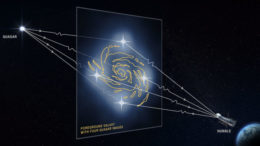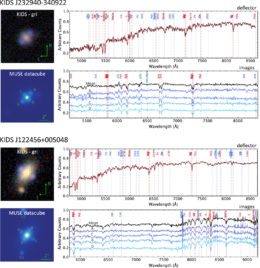Seeing quadruple? In a rare phenomenon, some distant objects can appear as four copies arranged in an “Einstein cross”. A new study has found two more of these unusual sights — with an unexpected twist.
Searching for Rare Crosses
Gravitational lensing — the bending of light by the gravity of massive astronomical objects — can do some pretty strange things. One of lensing’s more striking creations is the Einstein cross, a configuration of four images of a distant, compact source created by the gravitational pull of a foreground object (which is usually visible in the center of the four images).

Diagram illustrating how light from a distant source can be bent by a foreground object to produce four identical images of the source. Click to enlarge. [NASA/ESA/D. Player (STScI)]
In a new study led by Nicola Napolitano (Sun Yat-sen University Zhuhai Campus, China), a team of scientists presents confirmation of two new Einstein crosses discovered within the 1,000 square degrees imaged in the Kilo-Degree Survey using the Very Large Telescope (VLT) in Chile. Einstein crosses are unusual enough to begin with, but these two discoveries are especially rare: the lensed sources are not quasars. Instead, they’re entire galaxies.
Galaxies, but Bite-Size
When a distant galaxy is lensed by a foreground object, it’s commonly smeared out into an an arc or a ring; this is because galaxies are large, extended objects. But if a galaxy is compact enough, the entire galaxy can be lensed into quadruple images instead of a smeared-out ring. Such is the case with Napolitano and collaborators’ new discoveries, KIDS J232940-340922 and KIDS J122456+005048: they’re both quadruply lensed compact galaxies known as post-blue nuggets.

Detection and confirmation of the Einstein crosses, KIDS J232940-34092 (top two rows) and KIDS J122456+005048 (bottom two rows), via the KiDS survey and the MUSE integral field spectrograph on the VLT. Click to enlarge. [Napolitano et al. 2020]
Blue nuggets are thought to be suddenly quenched — their star formation is cut off — early in their evolution. As their star population then evolves, these post-blue nuggets then transition into red nuggets, compact collections of red stars that are theorized to become the cores of today’s large elliptical galaxies.
A Bright Future
By spectroscopically following up their Einstein cross discoveries, Napolitano and collaborators show that the two sources are both very compact, massive galaxies with low specific star formation rates. Their properties are consistent with post-blue nuggets currently undergoing quenching — which means that these Einstein crosses are excellent sources to study to learn about galaxy evolution.
The authors predict that, with future observatories like the Vera Rubin Observatory, Euclid, or the China Space Station Telescope, we may be able to find many thousands of Einstein crosses like these. There’s a lot to learn ahead!
Citation
“Discovery of Two Einstein Crosses from Massive Post-blue Nugget Galaxies at z > 1 in KiDS,” N. R. Napolitano et al 2020 ApJL 904 L31. doi:10.3847/2041-8213/abc95b


5 Comments
Pingback: From AAS NOVA: “Nugget Galaxies Cross in the Sky” | sciencesprings
Pingback: Dos nuevos fenómenos ópticos conocidos como cruces de Einstein se dejan ver en el cielo – La Verdad
Pingback: Descubren astrónomos dos nuevas cruces de Einstein en Galaxia activa – InsurgentePress
Pingback: Aparecen en el cielo dos nuevos fenómenos ópticos conocidos como cruz de Einstein
Pingback: Dos nuevos fenómenos ópticos conocidos como cruces de Einstein se dejan ver en el cielo | Dot News